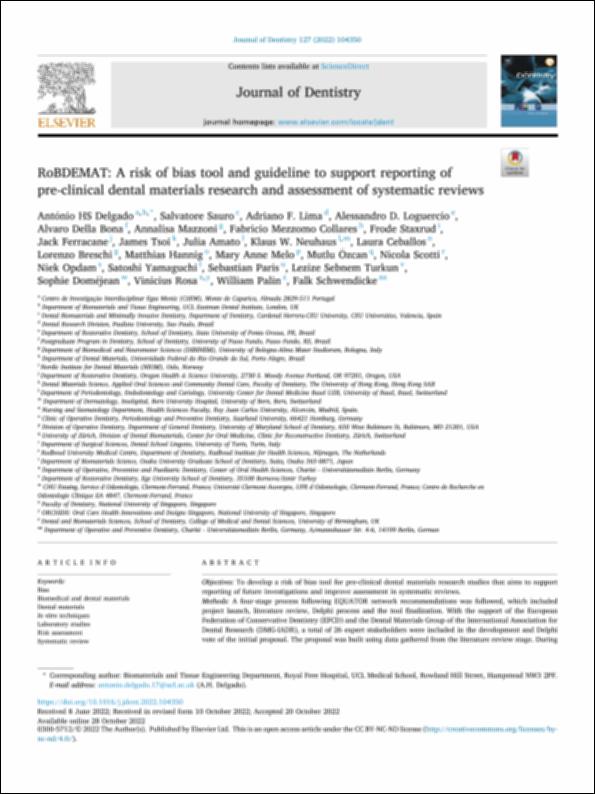Por favor, use este identificador para citar o enlazar este ítem:
http://hdl.handle.net/10637/14359RoBDEMAT a risk of bias tool and guideline to support reporting of pre-clinical dental materials research and assessment of systematic reviews
| Título : | RoBDEMAT a risk of bias tool and guideline to support reporting of pre-clinical dental materials research and assessment of systematic reviews |
| Autor : | Delgado, António H. S. Sauro, Salvatore. Lima, Adriano F. Loguercio, Alessandro D. Bona, Alvaro della Mazzoni, Annalisa |
| Materias: | Dental materials.; Materiales dentales. |
| Editorial : | Elsevier |
| Citación : | Delgado, A. H., Sauro, S., Lima, A. F., Loguercio, A. D., Della Bona, A., Mazzoni, A., Collares, F. M., Staxrud, F., Ferracane, J., Tsoi, J., Amato, J., Neuhaus, K. W., Ceballos, L., Breschi, L., Hannig, M., Melo, M. A., Özcan, M., Scotti, N., Opdam, N., Yamaguchi, S., … Schwendicke, F. (2022). RoBDEMAT: a risk of bias tool and guideline to support reporting of pre-clinical dental materials research and assessment of systematic reviews. Journal of Dentistry, vol. 127, art. 104350 (dec.). DOI: https://doi.org/10.1016/j.jdent.2022.104350 |
| Resumen : | Objectives: To develop a risk of bias tool for pre-clinical dental materials research studies that aims to support reporting of future investigations and improve assessment in systematic reviews. Methods: A four-stage process following EQUATOR network recommendations was followed, which included project launch, literature review, Delphi process and the tool finalization. With the support of the European Federation of Conservative Dentistry (EFCD) and the Dental Materials Group of the International Association for Dental Research (DMG-IADR), a total of 26 expert stakeholders were included in the development and Delphi vote of the initial proposal. The proposal was built using data gathered from the literature review stage. During this stage, recent systematic reviews featuring dental materials research, and risk of bias tools found in the literature were comprehensively scanned for bias sources. The experts thus reached a consensus for the items, domains and judgement related to the tool, allowing a detailed guide for each item and corresponding signalling questions. Results: The tool features nine items in total, spread between 4 domains, pertaining to the following types of bias: bias related to planning and allocation (D1), specimen preparation (D2), outcome assessment (D3) and data treatment and outcome reporting (D4). RoBDEMAT, as presented, features signalling questions and a guide that can be used for RoB judgement. Its use as a checklist is preferred over a final summary score. Conclusion: RoBDEMAT is the first risk of bias tool for pre-clinical dental materials research, supported and developed by a broad group of expert stakeholders in the field, validating its future use. Clinical significance: This new tool will contribute the study field by improving the scientific quality and rigour of dental materials research studies and their systematic reviews. Such studies are the foundation and support of future clinical research and evidence-based decisions. |
| Descripción : | Este artículo se encuentra disponible en la siguiente URL: https://www.sciencedirect.com/science/article/pii/S030057122200402X?via%3Dihub En este artículo de investigación también participan: Fabricio Mezzomo Collares, Frode Staxrud, Jack Ferracane, James Tsoi, Julia Amato, Klaus W. Neuhaus, Laura Ceballos, Lorenzo Breschi, Matthias Hannig, Mary Anne Melo, Mutlu Özcan, Nicola Scotti, Niek Opdam, Satoshi Yamaguchi, Sebastian Paris, Lezize Sebnem Turkun, Sophie Doméjean, Vinicius Rosa, William Palin y Falk Schwendicke. |
| URI : | http://hdl.handle.net/10637/14359 |
| Derechos: | http://creativecommons.org/licenses/by-nc-nd/4.0/deed.es |
| ISSN : | 0300-5712 |
| Idioma: | es |
| Fecha de publicación : | 27-dic-2022 |
| Centro : | Universidad Cardenal Herrera-CEU |
| Aparece en las colecciones: | Dpto. Odontología |
Los ítems de DSpace están protegidos por copyright, con todos los derechos reservados, a menos que se indique lo contrario.


